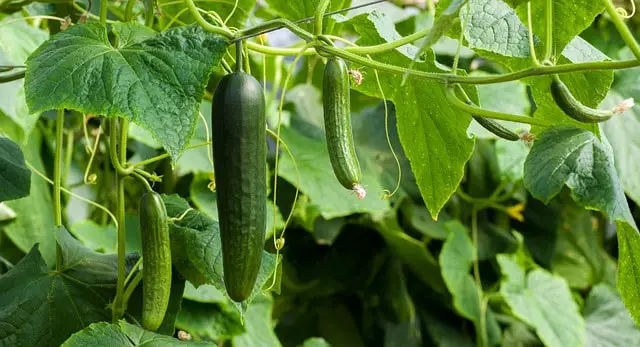Brown spots on cucumber leaves are a common issue for gardeners and can be caused by a variety of factors. These spots can indicate a fungal or bacterial infection, as well as environmental stressors like overwatering or nutrient deficiencies. If left untreated, brown spots can lead to a decrease in cucumber plant health and yield.
To effectively treat brown spots on cucumber leaves, it is important to first identify the underlying cause. Common diseases that cause brown spots include Alternaria leaf blight and angular leaf spot, which can be controlled through the use of fungicides and bactericides.
Environmental factors like overwatering and nutrient deficiencies can also contribute to brown spots, and preventative measures like proper watering and fertilization can help mitigate these issues.
When treating brown spots, it is important to consider the impact on the cucumber plant and yield. While brown spots may not directly harm the plant, they can weaken the plant’s overall health and lead to a decrease in yield.
Pests and insects can also contribute to brown spots, and it is important to monitor for these issues and treat as necessary. By taking a proactive approach to treating brown spots, gardeners can help ensure a healthy and productive cucumber crop.
Key Takeaways
- Identifying the underlying cause of brown spots is important for effective treatment.
- Brown spots can weaken the overall health of the cucumber plant and lead to a decrease in yield.
- Proper preventative measures, monitoring for pests and insects, and proactive treatment can help ensure a healthy and productive cucumber crop.
Related posts:
- How to Treat Brown Spots on Basil Leaves
- Brown Spots on Weed Leaves
- Brown Spots Under Monstera Leaves
Identifying Brown Spots on Cucumber Leaves
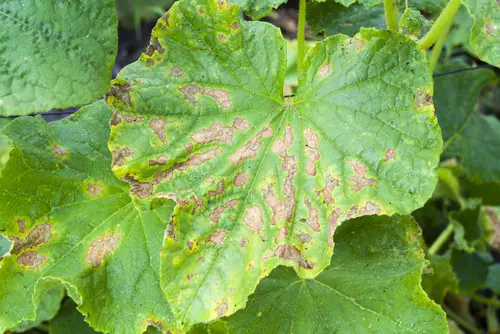
Brown spots on cucumber leaves can be caused by various factors such as bacterial and fungal infections, pests, and environmental stress. Identifying the cause of the brown spots is crucial in determining the appropriate treatment.
One of the most common causes of brown spots on cucumber leaves is a bacterial or fungal infection. These infections can cause circular or irregular-shaped spots on the leaves, which may be yellow, brown, or black in color. The spots may also have a yellow halo around them, and the leaves may eventually wilt and die.
Pests such as spider mites, aphids, and cucumber beetles can also cause brown spots on cucumber leaves. These pests feed on the leaves, causing damage that appears as brown spots. In some cases, the spots may also be accompanied by webbing or stippling on the leaves.
Environmental stress, such as drought, heat, or nutrient deficiencies, can also cause brown spots on cucumber leaves. In these cases, the spots may appear as yellow or brown and may be irregular in shape. The leaves may also be curled or wilted.
To accurately identify the cause of brown spots on cucumber leaves, it is important to carefully examine the leaves and look for any accompanying symptoms. For instance, if the spots are accompanied by webbing or stippling, this may indicate a pest infestation.
If the spots are circular and have a yellow halo, this may indicate a bacterial or fungal infection. If the spots are irregular in shape and accompanied by other symptoms such as wilting or leaf curling, this may indicate environmental stress.
Common Diseases Causing Brown Spots
Brown spots on cucumber leaves can be caused by various diseases, including bacterial and fungal infections. Identifying the specific disease causing the brown spots is essential to determine the appropriate treatment.
1. Anthracnose
Anthracnose is a fungal disease that causes circular, sunken brown spots on cucumber leaves. The center of the spot may fall out, giving the leaf a “shot hole” appearance.
The disease can also cause brown lesions on the fruit. Wet and warm conditions favor the disease, and it can spread through contaminated soil and water. Control measures include planting resistant varieties, crop rotation, and fungicide applications.
2. Bacterial Leaf Spot
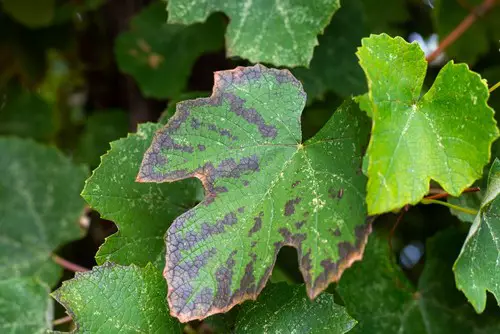
Bacterial leaf spot is caused by the bacteria Xanthomonas campestris. It causes small, water-soaked brown spots on the leaves that may enlarge and merge, leading to the death of the leaf.
The bacteria can survive on plant debris and in soil for several years, and it can spread through contaminated water, tools, and hands. Control measures include planting resistant varieties, crop rotation, and copper-based bactericides.
3. Angular Leaf Spot
Angular leaf spot is caused by the bacteria Pseudomonas syringae pv. lachrymans. It causes angular, water-soaked brown spots on the leaves, which may turn yellow and necrotic.
The bacteria can survive on plant debris and in soil for several months, and it can spread through contaminated water, tools, and hands. Control measures include planting resistant varieties, crop rotation, and copper-based bactericides.
4. Alternaria Leaf Blight
Alternaria leaf blight is caused by the fungus Alternaria cucumerina. It causes circular, water-soaked brown spots on the leaves that may enlarge and merge, leading to the death of the leaf.
The fungus can survive on plant debris and in soil for several years, and it can spread through contaminated water, tools, and hands. Control measures include planting resistant varieties, crop rotation, and fungicide applications.
5. Gummy Stem Blight
Gummy stem blight is caused by the fungus Didymella bryoniae. It causes circular, water-soaked brown spots on the leaves that may enlarge and merge, leading to the death of the leaf.
The fungus can also cause brown lesions on the stem and fruit. The disease can spread rapidly in warm and humid conditions, and it can survive on plant debris and in soil for several years. Control measures include planting resistant varieties, crop rotation, and fungicide applications.
6. Black Rot
Black rot is caused by the fungus Stagonosporopsis cucurbitacearum. It causes circular, sunken brown spots on the leaves that may enlarge and merge, leading to the death of the leaf.
The fungus can also cause brown lesions on the stem and fruit. The disease can spread rapidly in warm and humid conditions, and it can survive on plant debris and in soil for several years. Control measures include planting resistant varieties, crop rotation, and fungicide applications.
7. Verticillium Wilt
Verticillium wilt is caused by the fungus Verticillium dahliae. It causes yellowing and wilting of the leaves, followed by brown spots and necrosis. The fungus can survive in soil for several years, and it can spread through contaminated water, tools, and hands.
Control measures include planting resistant varieties, crop rotation, and fungicide applications.
8. Septoria Leaf Spot
Septoria leaf spot is caused by the fungus Septoria cucurbitacearum. It causes circular, water-soaked brown spots on the leaves that may enlarge and merge, leading to the death of the leaf.
The fungus can survive on plant debris and in soil for several years, and it can spread through contaminated water, tools, and hands. Control measures include planting resistant varieties, crop rotation, and fungicide applications.
9. Fusarium Wilt
Fusarium wilt is caused by the fungus Fusarium oxysporum f. sp. cucumerinum. It causes yellowing and wilting of the leaves, followed by brown spots and necrosis.
The fungus can survive in soil for several years, and it can spread through contaminated water, tools, and hands. Control measures include planting resistant varieties, crop rotation, and fungicide applications.
10. Phytophthora Blight
Phytophthora blight is caused by the fungus Phytophthora capsici. It causes water-soaked brown spots on the leaves that may enlarge and merge, leading to the death of the leaf.
The fungus can also cause brown lesions on the stem and fruit. The disease can spread rapidly in warm and humid conditions, and it can survive on plant debris and in soil for several years. Control measures include planting resistant varieties, crop rotation, and fungicide applications.
Role of Environmental Factors

Environmental factors play a crucial role in the development and spread of brown spots on cucumber leaves. Cucumbers are susceptible to a range of fungal and bacterial diseases that can be triggered by various environmental conditions.
Here are some of the factors that can contribute to the development of brown spots on cucumber leaves:
1. Weather
Weather conditions can have a significant impact on the health of cucumber plants. High humidity and wet conditions can create an ideal environment for fungal and bacterial growth, which can lead to the development of brown spots on cucumber leaves.
Temperature fluctuations can also stress the plant and make it more vulnerable to disease.
2. Moisture
Moisture is another critical factor that can contribute to the development of brown spots on cucumber leaves. Overwatering or watering at the wrong time of day can create moist conditions that are conducive to fungal and bacterial growth.
On the other hand, underwatering can stress the plant and make it more susceptible to disease.
3. Fungi
Fungi are one of the primary causes of brown spots on cucumber leaves. Fungal spores can be carried by wind or spread through contaminated soil and water. Wet and warm conditions favor the growth of fungi, which can survive the winter in plant debris and attack the plants again in the spring.
4. High Humidity
High humidity can create a moist environment that is ideal for the growth of fungi and bacteria. When humidity levels are high, it is essential to ensure that the plants have adequate air circulation to reduce the risk of disease.
5. Wet Conditions
Wet conditions can also contribute to the development of brown spots on cucumber leaves. When plants are wet for an extended period, it can create an ideal environment for fungal and bacterial growth, which can lead to the development of disease.
Preventive Measures and Treatment
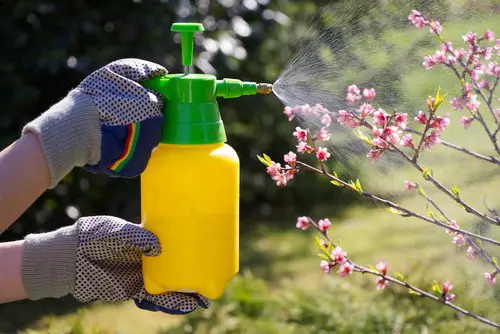
1. Proper Watering
One of the most important preventive measures to take is to ensure that cucumbers are properly watered. Overwatering can lead to fungal growth, while underwatering can cause stress to the plant, making it more susceptible to disease.
It is recommended to water cucumbers deeply once a week, ensuring that the soil is moist but not waterlogged.
2. Adequate Spacing
Another important preventive measure is to ensure that cucumbers are planted with adequate spacing. Crowded plants can lead to poor air circulation, which can increase the likelihood of fungal growth. It is recommended to space cucumber plants at least 12 inches apart in rows that are 3-4 feet apart.
3. Regular Pruning
Regular pruning can help prevent the growth of fungal diseases. It is recommended to remove any diseased leaves or branches as soon as they are spotted. This can help prevent the spread of disease to healthy parts of the plant. Additionally, pruning can help increase air circulation, which can reduce the likelihood of fungal growth.
4. Use of Fungicides and Bactericides
Copper fungicides can be effective in preventing the growth of fungal diseases on cucumber leaves. These fungicides work by preventing fungal spores from germinating, which can stop the spread of disease. Bactericides can also be effective in preventing bacterial diseases on cucumber leaves.
5. Cultural Practices
Cultural practices such as crop rotation, proper fertilization, and mulching can also help prevent the growth of fungal diseases. Crop rotation can help prevent the buildup of soil-borne diseases, while proper fertilization can help maintain the health of the plant.
Mulching can help retain moisture in the soil and prevent the growth of weeds, which can compete with the cucumber plant for nutrients.
Impact on Cucumber Plant and Yield
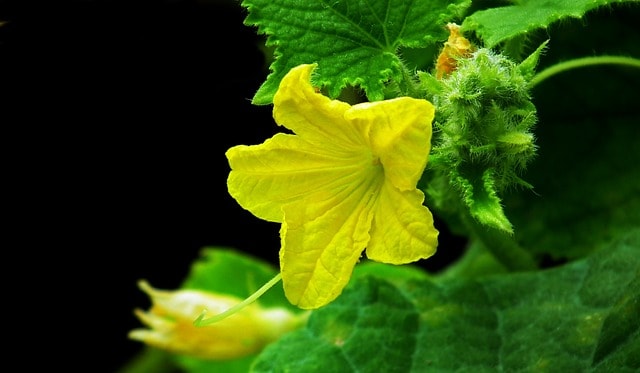
Brown spots on cucumber leaves can have a significant impact on the plant and its yield. The spots are an indication that something is wrong with the plant, and if left untreated, the plant may eventually die.
One of the primary functions of the leaves is photosynthesis, which is the process by which the plant converts sunlight into energy. When the leaves are damaged, they cannot perform this function effectively, and the plant may not produce enough energy to grow properly.
As a result, the yield of the cucumber plant may be reduced, and the fruit may not grow to its full potential.
In addition to affecting photosynthesis, brown spots on cucumber leaves can also be a sign of disease. For example, cucumber mosaic virus and downy mildew are two common diseases that can cause brown spots on the leaves.
These diseases can be spread from plant to plant, and if left untreated, they can cause widespread damage to the crop.
To prevent the spread of disease, it is essential to remove any infected leaves as soon as possible. If the disease has already spread, it may be necessary to use a fungicide to treat the entire plant. It is also important to ensure that the plants are well-watered and that they receive adequate sunlight and nutrients.
In addition to disease, brown spots on cucumber leaves can also be caused by environmental factors, such as extreme temperatures or lack of water. To prevent this, it is important to provide the plants with the appropriate growing conditions, including the right amount of water and nutrients.
Pests and Insects Role
Brown spots on cucumber leaves can be caused by various factors, including pests and insects. Insects like cucumber beetles, aphids, mites, and four-lined plant bugs can cause damage to cucumber leaves, which can lead to brown spots.
Cucumber beetles are a common pest that can cause damage to cucumber plants. They feed on the leaves and stems of the plant, which can lead to brown spots on the leaves. These pests can also transmit bacterial wilt, which can cause the plant to wilt and die.
Aphids are another common pest that can cause damage to cucumber plants. They feed on the sap of the plant, which can lead to stunted growth and brown spots on the leaves. They can also transmit viruses that can cause further damage to the plant.
Mites are another type of pest that can cause damage to cucumber plants. They feed on the underside of the leaves, which can cause yellowing and brown spots on the leaves. These pests can also cause the leaves to become distorted and curled.
Four-lined plant bugs are another type of insect that can cause damage to cucumber plants. They feed on the leaves and stems of the plant, which can cause brown spots on the leaves. They can also cause the plant to become stunted and deformed.
In addition to pests and insects, a pest infestation can also cause brown spots on cucumber leaves. If left untreated, a pest infestation can cause significant damage to the plant and reduce the yield.
To prevent pest infestations, it is important to practice good garden hygiene. This includes removing any dead or diseased plant material, rotating crops, and keeping the garden free of weeds. It is also important to monitor the garden regularly for signs of pests and insects and to take action immediately if an infestation is detected.
Dealing with Overwatered Cucumbers

Overwatering is a common problem that can lead to brown spots on cucumber leaves. When cucumbers are overwatered, their roots become waterlogged and are unable to absorb oxygen, leading to poor growth and disease susceptibility. Here are some tips for dealing with overwatered cucumbers:
- Check the soil moisture regularly: Overwatered cucumbers often have yellowing leaves, especially near the base of the plant. If you spot them, check the soil moisture first. The soil should be moist but not waterlogged. If the soil is waterlogged, it is time to cut back on watering.
- Improve drainage: If the soil is heavy clay, add sand to improve drainage. Cucumbers prefer well-draining soil, so it is important to ensure that water is not sitting in the soil for too long.
- Repot the cucumber: If the damage is minor, it may be possible to save the cucumber plant by repotting it in fresh soil with good drainage. This will help to improve the root health of the plant.
- Avoid poor soil conditions: Cucumbers grow best in soil that is rich in nutrients and has good drainage. If the soil is poor, it may be necessary to add compost or other organic matter to improve the soil quality.
It is important to note that overwatering is not the only cause of brown spots on cucumber leaves. Other factors such as fungal diseases like Alternaria leaf blight can also cause brown spots on cucumber leaves.
If the problem persists, it may be necessary to consult with a gardening expert or plant pathologist to identify the root cause of the problem.
Conclusion
Treating brown spots on cucumber leaves is essential to ensure a healthy and productive cucumber plant. Brown spots are usually caused by fungal or bacterial infections, and the best way to treat them is by using a combination of preventive measures and targeted treatments.
Preventive measures include maintaining proper plant hygiene, avoiding overhead watering, and providing adequate air circulation. Targeted treatments include using fungicides or bactericides and removing infected leaves and plants.
It is important to note that not all brown spots are harmful, and some may be caused by environmental factors such as sunscald or nutrient deficiencies. Therefore, it is crucial to identify the cause of the brown spots before applying any treatment.
If the brown spots are caused by fungal infections such as Alternaria leaf blight or anthracnose, fungicides such as copper-based fungicides or chlorothalonil can be used to prevent further spread. For bacterial infections such as bacterial wilt or angular leaf spot, bactericides such as copper-based bactericides or streptomycin can be used.
Removing infected leaves and plants can also help prevent the spread of the infection. Infected leaves should be removed immediately and disposed of in the trash to avoid contaminating the soil. Infected plants should be removed and destroyed to prevent the infection from spreading to other plants.
Frequently Asked Questions

What causes yellow spots on cucumber leaves?
Yellow spots on cucumber leaves are often caused by a fungal infection known as downy mildew. This disease thrives in cool, moist conditions and can spread rapidly in humid weather.
It is important to remove any infected leaves as soon as they are spotted to prevent the disease from spreading.
How to prevent cucumber leaf blight?
Cucumber leaf blight is caused by a fungus that thrives in warm, humid conditions. To prevent this disease, it is important to keep the leaves dry by watering the plants at the base and avoiding overhead watering.
Good air circulation is also important, so make sure to space the plants properly and prune any excess foliage.
What is the best fungicide for treating cucumber plant diseases?
There are several fungicides available for treating cucumber plant diseases, but it is important to choose one that is specifically designed for the disease you are trying to treat.
Copper-based fungicides are effective against a wide range of fungal diseases, while sulfur-based fungicides are more effective against powdery mildew. Always follow the manufacturer’s instructions when using fungicides.
How to stop cucumber leaves from turning brown and drying up?
Cucumber leaves can turn brown and dry up due to a variety of reasons, including fungal infections, pests, and environmental stress. To stop this from happening, it is important to identify the underlying cause and address it accordingly.
Remove any infected or damaged leaves and make sure the plants are getting enough water and nutrients.
When should you remove diseased cucumber leaves?
Diseased cucumber leaves should be removed as soon as they are spotted to prevent the disease from spreading to other parts of the plant. It is important to remove the entire leaf, including the stem, to prevent any spores from spreading.
Make sure to dispose of the infected leaves in a sealed plastic bag to prevent the disease from spreading to other plants.
How to treat cucumber leaf spot effectively?
Cucumber leaf spot is caused by a fungal infection that can be treated with a copper-based fungicide. It is important to remove any infected leaves and avoid overhead watering to prevent the disease from spreading.
Good air circulation is also important, so make sure to space the plants properly and prune any excess foliage.

Hey, I’m Lisa and I’ve been an avid gardener for over 30 years. I love writing, talking and living in the garden! Feel free to connect with me on my socials below

